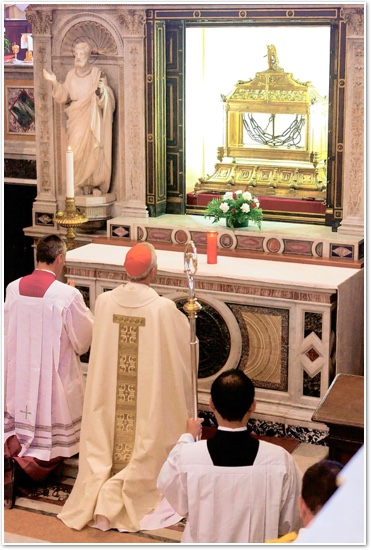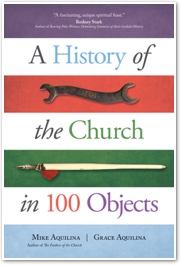The Chains of St. Peter in Rome
- MIKE AQUILINA & GRACE AQUILINA
Two lengths of fetters are here fused in a single chain, displayed in a church all its own near the Roman Colosseum.

The bonds, according to tradition, once held fast the limbs of St. Peter the Apostle and have been cherished by Christians since the first century.
The story of their veneration first appears in the ancient Acts of Saint Alexander, an early pope who died as a martyr in AD 115. As he awaited his own execution, he received a visit from Quirinus, the nobleman who oversaw the prisons in Rome. The man's daughter Balbina was desperately ill, and he had heard that Pope Alexander had the power to heal her. She was completely cured when the pope touched her with his chains. Balbina wanted to kiss the chains in gratitude — but Alexander instructed her to find the chains of St. Peter and honor them instead.
Balbina became a Christian — and, according to some accounts, a consecrated virgin — and she arranged for the construction of a shrine for St. Peter's fetters. It would be rebuilt and moved and expanded through the centuries.
In scripture we find St. Peter imprisoned twice in Jerusalem. Once he was jailed with the rest of the apostles and set free by an angel (Acts 5:17–25). The second time, the authorities took no chances. They assigned him two guards and bound him in his cell with double chains. But, again, "an angel of the Lord appeared, and a light shone in the cell; and he struck Peter on the side and woke him. . . . And the chains fell off his hands" (Acts 12:7).
Once freed, Peter brought the Gospel first to Syrian Antioch and then to Rome. In the imperial capital, during the reign of Nero, he was jailed briefly in the Mamertine Prison before suffering death by crucifixion.
 Iron chains became, paradoxically, an early symbol of Christian freedom. They are, according to St. Polycarp, writing in the second century, "the fitting ornaments of saints, and . . . indeed the diadems of the true elect of God and our Lord." Though the emperors possessed the power to chain the popes — from Peter to Alexander and beyond — the Church endured and triumphed. Christians, from at least the fourth century, celebrated a feast of St. Peter's chains on August 1, the beginning of the month named for Rome's first emperor, Augustus.
Iron chains became, paradoxically, an early symbol of Christian freedom. They are, according to St. Polycarp, writing in the second century, "the fitting ornaments of saints, and . . . indeed the diadems of the true elect of God and our Lord." Though the emperors possessed the power to chain the popes — from Peter to Alexander and beyond — the Church endured and triumphed. Christians, from at least the fourth century, celebrated a feast of St. Peter's chains on August 1, the beginning of the month named for Rome's first emperor, Augustus.
As Rome's Christians honored Peter's chains from the Mamertine, so the Church in Jerusalem kept his chains from the Herodian prison. In the fifth century, the Christian empress Eudocia, the wife of Theodosius II, sent a length of Peter's Jerusalem chains to St. Leo the Great. According to tradition, Leo held it beside Peter's chains from the Mamertine Prison, and the two miraculously, inseparably fused together.
There are abundant testimonies to the presence of these chains in Rome. St. Gregory the Great, who reigned as pope from 590 to 604, was intensely devoted to the relic and often sent small filings as gifts to dignitaries — to Constantina Augusta, the Byzantine empress; to a bishop named Columbus; to King Childebert of the Franks; to King Rechared of the Visigoths; and to Theodore, the court physician at Constantinople. He would place the filing in a key-shaped reliquary — the key representing Peter's authority. He sent each particle with a prayer "that what bound [Peter's] neck for martyrdom, may loose yours from all sins."
The chains are today exposed for veneration in a gold and glass reliquary in the Basilica of San Pietro in Vincoli, on Rome's Oppian Hill, a church built in the fifth century during the reign of Leo the Great.
Peter's chains remain a sign of the relationship, often uneasy, between throne and altar, bishops and emperors. In 2010 Pope Benedict XVI granted the title of the basilica to the cardinal-archbishop of Washington, DC.

Read the introduction to
A History of the Church in 100 Objects, here.

 This is J. Fraser Field, Founder of CERC. I hope you appreciated this piece. We curate these articles especially for believers like you.
This is J. Fraser Field, Founder of CERC. I hope you appreciated this piece. We curate these articles especially for believers like you.
Please show your appreciation by making a $3 donation. CERC is entirely reader supported.

Acknowledgement
 Mike Aquilina & Grace Aquilina. "The Chains of St. Peter in Rome" chapter 9 from A History of the Church in 100 Objects (Notre Dame: Ave Maria Press, 2017): 39-41.
Mike Aquilina & Grace Aquilina. "The Chains of St. Peter in Rome" chapter 9 from A History of the Church in 100 Objects (Notre Dame: Ave Maria Press, 2017): 39-41.
Reprinted with permission of Ave Maria Press.
The Author

 Mike Aquilina is vice president of the St. Paul Center for Biblical Theology. He is the author or co-author of fifty books including A History of the Church in 100 Objects, Seven Revolutions: How Christianity Changed the World and Can Change It Again, Yours is the Church: How Catholicism Shapes Our World, Good Pope, Bad Pope: Their Lives, Our Lessons, Love in the Little Things: Tales of Family Life, Living the Mysteries: A Guide for Unfinished Christians, Fathers of the Church: An Introduction to the First Christian Teachers, The Way of the Fathers: Praying with the Early Christians, and Praying in the Presence of Our Lord: With St. Thomas Aquinas. With Cardinal Donald Wuerl, he is the author of The Church: Unlocking the Secrets to the Places Catholics Call Home, and The Mass: The Glory, the Mystery, the Tradition. See Mike Aquilina's "The Way of the Fathers" blog here.
Mike Aquilina is vice president of the St. Paul Center for Biblical Theology. He is the author or co-author of fifty books including A History of the Church in 100 Objects, Seven Revolutions: How Christianity Changed the World and Can Change It Again, Yours is the Church: How Catholicism Shapes Our World, Good Pope, Bad Pope: Their Lives, Our Lessons, Love in the Little Things: Tales of Family Life, Living the Mysteries: A Guide for Unfinished Christians, Fathers of the Church: An Introduction to the First Christian Teachers, The Way of the Fathers: Praying with the Early Christians, and Praying in the Presence of Our Lord: With St. Thomas Aquinas. With Cardinal Donald Wuerl, he is the author of The Church: Unlocking the Secrets to the Places Catholics Call Home, and The Mass: The Glory, the Mystery, the Tradition. See Mike Aquilina's "The Way of the Fathers" blog here.
Grace Aquilina is a freelance editor who lives in Pittsburgh, Pennsylvania.
Copyright © 2017 Ave Maria Press

